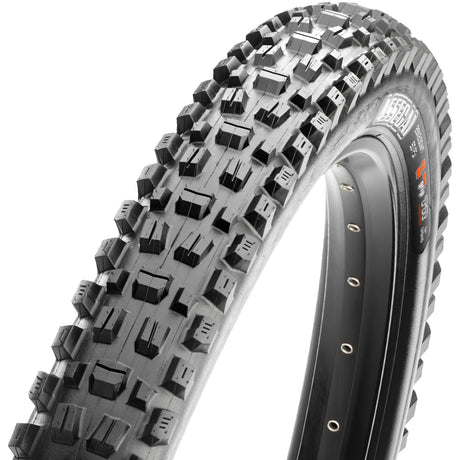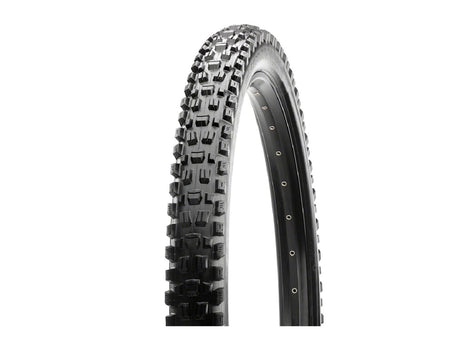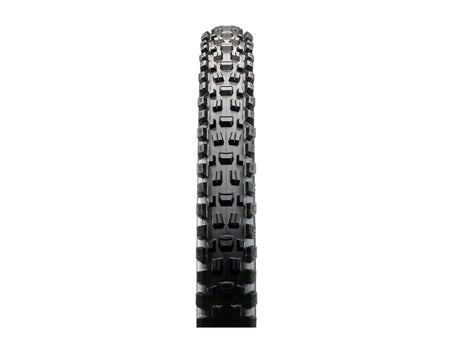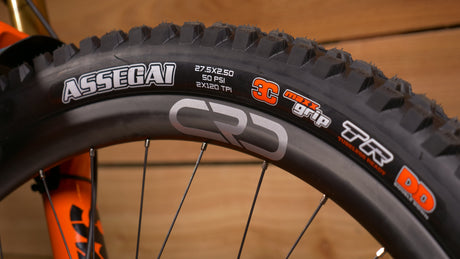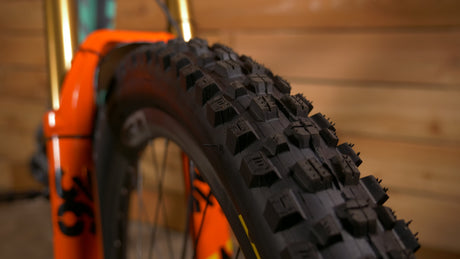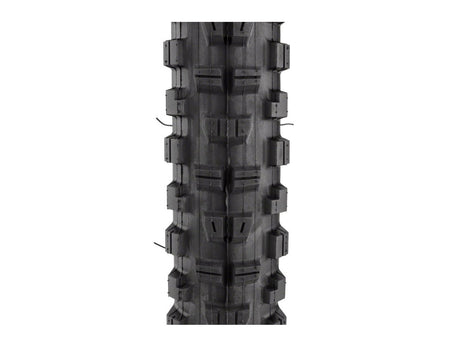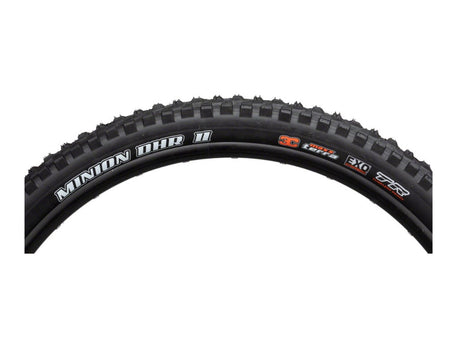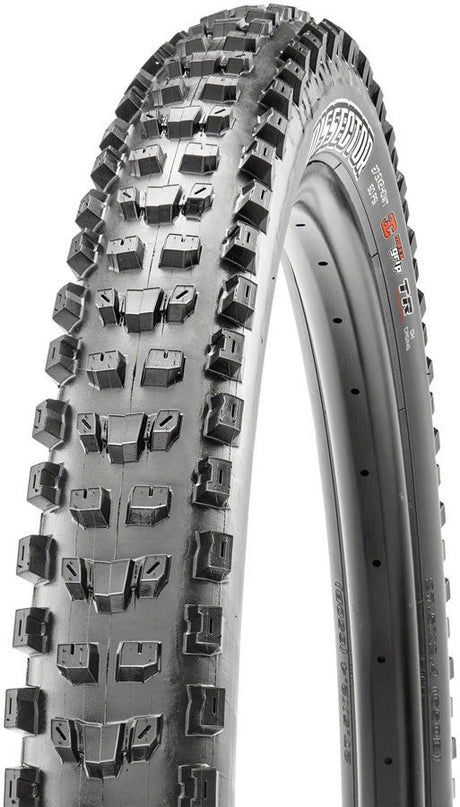EXO vs EXO+ vs Double Down vs Downhill Casings
When shopping for mountain bike tires, you will see there’s different options for both the tire’s sidewall, and the rubber compound. With so many different configurations, matching your personal preferences and riding style to the right configuration can be confusing. In another blog, we will be covering compounds, but in this blog...
We’re going to be talking about the different options for the tire sidewall.
Over the years, there’s been a bunch of options from Maxxis, but in this day and age for the tire models for trail through downhill riding, the sidewall options are EXO, EXO+, Double Down and DH. These different options will give you more or less stiffness and support, and more or less puncture resistance. Basically, these different options just refer to how tough and burly the tire is, and the different designs change the weight and riding characteristics of each tire.
Now before we begin comparing tires, we wanted to briefly touch on the acronym TPI, which is threads per inch.
There’s 60 TPI or 120 TPI and it just refers to how many threads there are in each square inch of the rubber in the tire’s casing. We could talk about TPI on a video call with a tire engineer for 30 minutes, but in the end that number doesn’t really matter much since the TPI changes in each model of sidewall, so let’s basically just pretend it isn’t there as it will only worsen your analysis paralysis in deciding between so many configurations and just focus on the sidewall model name.
Ok, let’s get into it!
Overview of Each Maxxis Casing
There are four different sidewall casings to choose from. EXO is the lightest casing, then there is the more puncture resistant EXO+, then the burlier Double Down, and finally the heaviest, burliest DH casing.
So basically EXO is the lightest, DH is the burliest, and the others fall in between.
When you feel these tires in your hand, you can totally feel how thick the sidewalls are. You can easily flex and maneuver the EXO tire by hand, and each tire gets gradually more stiff and harder to flex as you work your way to the DH tire, which is very noticeably harder to flex than EXO.
Before we chit chat about how these ride, let’s go over the descriptions from Maxxis for each sidewall.
"EXO is an extremely cut-resistant and abrasion-resistant material added to the sidewalls. This densely woven fabric is also lightweight and highly flexible, ensuring that the performance of the tire remains unaffected. Choose EXO Protection for exceptionally rocky, treacherous trails where the chance of sidewall cuts and abrasions is high."
"EXO+ combines two of our best puncture protection materials: SilkShield and EXO. The SilkShield layer runs from bead-to-bead with a layer of EXO along the sidewalls. Combined, these two materials create EXO+ which improves tread puncture protection by 27%; sidewall durability by 51%; and resistance to pinch flats by 28%."
"DoubleDown (DD) is the next step in the evolution of the dual-ply tyre casing for enduro and downhill racing. Two 120 TPI casing layers reinforced with a butyl insert provide the rider with the support and protection of a MTB tyre, but in a lighter package."
"Downhill (DH) utilizes two layers of 60 TPI casing material used from bead-to-bead, providing additional protection and sidewall stiffness for the most demanding enduro and downhill applications."
A Note On Maxxis Sidewall Weights
Before talking about how they ride, let’s talk weight. We’ll use the 29" by 2.5" Maxxis Assegai for comparison, since that is one of our best selling tires.
EXO = 1,075 g
EXO+ = 1,125 g
DD = 1,305 g
DH = 1,334 g
EXO and EXO+ are super close in weight, then there’s a big jump up to the Double Down, which is also super close to the DH.
How Each Sidewall Rides
On the trail, each model of sidewall rides noticeably different from each other. But, to be totally honest, most riders that come into the shop aren’t even thinking about their sidewalls. Why is this? Likely due to the fact that EXO tires work so well for the average rider. But, If you are reading this article, chances are that you ARE thinking about your sidewalls... So, lets talk sidewalls.
In a nutshell, the more aggressive you ride, the thicker the sidewall you’ll want not only for less squirm and more stability, but also better puncture resistance to help protect against those evil flats. Remember, tires are the only form of contact that your bike has to the trail, so every corner you slash and rock you smack are directly in contact with your tires, and only your tires. The harder you slash those corners, and the harder you smack those rocks, the more abuse your tire is working against.
Let’s clarify some lingo that we often use when referring to how a tire rides when helping customers choose the right tire for them and their riding style.
- “Squirm” refers to how much side-to-side flex you can feel in the tire when either riding straight or cornering.
- "Pop” refers to how easily the tire makes your bike want to leave the ground / how lively it makes the bike feel.
And last but not least, be honest with yourself on how aggressive you ride. You don’t want to end up with heavy DH casing tires on an XC bike as that will take some of the fun out of riding that bike. So let’s set you up for success and talk about how these sidewalls ride on the trail.
EXO
First, let’s start with the lightest-duty sidewall, EXO. This is the lightest weight sidewall model from Maxxis (when referring to their trail through downhill tire models) which is nice for a majority of riders, because who doesn’t want a super light bike?
EXO tires are, without a doubt, the most widely ridden tire on the trails today
because they come stock on so many complete bikes from the factory.
Since they’re so popular, and many are familiar with EXO, this will be the longest section because I’ll be basing everything off of the EXO riding characteristics. EXO is a great option for a large majority of mountain bikers. Riding blues and blacks at an average pace, EXO tires ride well enough that you would never think you need anything else. There’s enough flat protection to prevent you from cursing at the sky very often, but the sidewall support is great for small to medium size drops, jumps and berms. Further, EXO are light, which allows the tire to spin up quickly. But when you start breaking out of the “average” aggressiveness, whatever the heck that means, you will begin to desire more.
Personally, when riding a 130mm-ish travel trail bike, I’m fond of EXO tires. I don’t have much suspension, so I’m sort of limited to how hard I can ride. I’m not out hunting the biggest gaps, I'm just out to have a good time and enjoy my time away from the office. On my most frequently ridden bike, a Devinci Spartan with 165mm of travel, riding fast and hard is what I’m after to put a smile on my face. So here’s how EXO tires feel on my 165mm travel enduro bike.
The sidewalls are thin, so the tire can be easily compressed and quickly rebound, meaning I can pop my way around the trail like a 5 foot 8 bunny rabbit on a plastic trail machine (which is pretty dang fun). However, riding fast through chunky sections is where I wish I had a thicker sidewall. The thin EXO sidewalls flex enough to cause an excessive amount of squirm. This makes me feel a bit uneasy in high-speed sections as the stability is a bit lackluster. Also, when cornering very hard on berms, the sidewall will squirm so much that I can easily "burp" the tire. Burping a tire refers to slightly un-seat the tire bead from the rim, letting some air out.
In very hard cornering, some riders can even completely tear the tire off the rim, but this is really just the upper-echelon of riders. Lastly, I don’t feel as if EXO tires have enough puncture resistance for the type of riding I’m doing on the longer travel rig. Since the sidewalls are very thin, when I smack a rock hard enough to ping my rim, EXO can easily pinch. Remember when you used to run tubes and got pinch flats? No… you forget? Well, install an EXO tire and ride fast directly into a rock for a quick reminder. I’m probably being dramatic, but might happen when pushing EXO tires past their threshold.
Pro tip: If you are traveling to a bike park, do yourself a favor and ditch your EXO tires to avoid flat tires so you can spend more time enjoying your trip and less time fixing flat tires.
PROS
- Lightweight, causing your bike to spin up quickly and feel fast
- A very “poppy” and playful feel
- Enough puncture resistance and support for most riders
- You probably already have them
CONS
- When riding aggressively, you will quickly desire more support and puncture resistance
- Easier to get flat tires depending on how rough your terrain is
EXO+
My last bike was a Devinci Troy with 140mm of travel, which I rode with downhill bike mentality, so I went with the slightly burlier EXO+ tires front and rear. The thicker sidewall of the EXO+ tires adds a virtually unnoticeable amount of weight (50g per tire), but you get a noticeable difference in sidewall support which is exactly what I was aiming for with this mid-travel bike.
Knock on wood, but I have never had a flat tire with EXO+ tires riding in Bellingham, but I have had many flats with EXO tires. The added puncture resistance of the Silkshield layer within the EXO+ tires did seem to work most excellently, which lead to more confidence in my rides. The added stability in rough sections of trail definitely gave me more confidence as well. The stability wasn’t DH level, but it was definitely noticeable.
The tire still has plenty of pop, but the thicker sidewalls deaden that a slight bit. I don’t think most riders would notice that difference. The thicker sidewall also makes the tire squirm and roll over less in corners, making it a bit harder to burp the tire. After spending about 6 months on EXO+ tires, I thought about how happy I was that Maxxis started making this sidewall. I believe they are the perfect tire for the average rider looking to up the ante in their riding.
If you’re on any bike from 130mm through 170mm of travel with EXO tires, and you like how light the tires are, but you want a bit more stability and puncture resistance, then the EXO+ will be perfect for you. However, once you start riding even harder, live in an area with trillions of sharp rocks, or you’re a heavier rider, then you may want even more…
PROS
- Very lightweight, nearly the same weight as EXO
- More stable than EXO in high-speed sections and in corners
- More puncture resistance
- Excellent for the average rider looking to get a bit more spicy
CONS
- Slightly heavier than EXO, so this is a con for weight weenies
- May not be burly enough for certain riders pushing the limits
Double Down
Ahh yes, now to my favorite; the Double Down sidewall.
Why is this my favorite? Well, simply put, these are downhill-esque tires in a slightly more lively and lightweight package. Since I love riding my trail bike like a downhill bike, this tire ticks all of the boxes for me.
Double Down uses two lightweight sidewalls in the tire casing to make them lighter and more supple than the burliest DH sidewall model. These tires are great for anyone else who likes to ride their trail bike like a downhill bike. In Bellingham, we do lots of very long climbs to get to equally long descents on steep, rowdy trails. Double Downs are perfect for this as their weight is light enough to not destroy your legs or lungs on the climb, and they’re burly enough to make you confident to not hold anything back on the descent.
On paper, the Double Down tires obviously weigh a bit more than EXO+ (180g per tire) and it’s slightly noticeable on the climbs. But I promise, once you point down the mountain, any worry about weight will dissipate with the cloud of dust behind you. There’s nothing worse than pedaling up to a gnarly trail, only to ride down with a little bit of hesitation, trying to avoid getting a flat or smacking your rim.
To most aggressive riders, the Double Down sidewalls have enough girth to conquer any sort of sidewall flex or squirm in high-speed straightaways or corners . When plowing through chunder at mach speeds, you feel MUCH more planted and stable compared to EXO or EXO+. You can let off the brakes more, point the bike where you want to go, and let ‘er rip. The stiff sidewalls are harder to compress, and when they do, they rebound slower. This does give it less pop, but it creates an incredibly supportive and confidence inspiring feel. The confidence and support from a DD will lead you to riding faster more comfortably.
I also ride Double Down tires front and rear in the bike park as they have historically had enough puncture resistance to keep me rolling through Whistler’s most rugged trails, day in and day out. The Maxxis Double Down sidewall option makes for a true enduro tire, and I’m confident it will inspire confidence in riders really looking to push their riding to the next level.
PROS
- Tons of stability and puncture resistance for anyone who loves riding their trail bike like a downhill bike
- Best option for enduro riding/racing
- Much more planted than EXO+
- Truly confidence inspiring
CONS
- Weighs a bit more, which is a bit noticeable when climbing
- A bit less lively and poppy than EXO+
Downhill
Last but not least, there’s the DH sidewall option.
Just like EXO, DH has been around for a very long time and DH sidewall tires come stock on many bikes (just a different style of bike). If you’re buying a new downhill bike, chances are they will come stock with DH sidewall tires.
These are the heaviest, burliest sidewalls. And you guessed it, they’re also the most stiff, the most supportive, and the most puncture resistant option. Like Double Down (which uses 120 TPI), DH casing uses 2 sidewalls, but the dual sidewalls are heavier (60 TPI). Don’t pay much attention to those TPI numbers, as they don’t really matter but I just wanted to throw them in there for the bike nerds.
DH sidewalls are great options for anyone with a true downhill bike with 200mm of travel and a dual crown fork, because these bikes are meant for one thing and one thing only… GOING DOWNHILL AS FAST AS POSSIBLE. No need for lightweight tires when you’re either on a chairlift or in a shuttling where you don't have to worry about pedaling up.
Even if you have a trail/enduro bike, DH tires may still be a great choice for you. First, they aren’t that much heavier than Double Down (29g per tire), but they are burlier leading to a different feel on the trails. For example, DH tires ride even more planted and inspire more confidence than Double Down when pushed very hard. However, Double Down is more active, lively, and has more pop than DH tires due to the slightly lighter and more compliant sidewalls.
Beyond those with downhill bikes, riders that may enjoy DH tires over Double Downs are
- Heavier riders who ride very aggressively
- Aggressive riders that live in an area with very sharp rocks as far as the eye can see
TL;DR: If you just need to burliest possible tires because all others have failed the task of staying alive, then go DH.
PROS
- Burly, heavy duty, ready to tackle literally anything you can hand to them
- The best option for downhill bikes
- Did I say burly??
CONS
- The heaviest sidewall option
- Least amount of “pop”
- Slowest rolling
- Could easily be overkill for many riders
With that all said, I recommend trying different sidewall options and seeing which works best for you. If you know your riding style and terrain, then you should be able to decide which sidewall will match that combo best.
You can also mix’n’match front and rear. Most of your weight is transferred over the rear wheel, so we recommend putting a more firm sidewall option in the rear. For example: If your bike has EXO tires front and rear, try using an EXO+ tire in just the rear. This will keep the weight down, but reduce squirm and increase puncture resistance in the rear tire.
Lately I haven’t been shuttling/chairlift-ing as much, and my preferred tire setup is EXO+ front and Double Down rear on my enduro bike. On a mid-travel trail bike, I prefer EXO+ front and rear. Also keep in mind that tires with thicker sidewalls need less air pressure to feel as supportive as lighter weight sidewall tires. With an EXO tire in the rear, I might run 28 psi, but with Double Down, I’ll run 24 psi since the DD is naturally more stiff.
Last but not least, tire inserts impact the sidewall feel as well. On my enduro bike, I generally always have a Double Down tire in the rear. However, I’ve been experimenting with EXO+ in the rear with a CushCore tire insert. CushCore puts pressure on the tire bead, meaning it’s lending a helping hand to the tire itself when it comes to hanging on and being supportive. I haven’t had a flat tire yet, and it feels quite stable. So far so good, but I would still be hesitant to bring this setup to Whistler Bike Park in fear of sharp pointy rocks.

